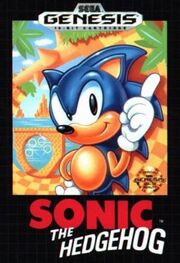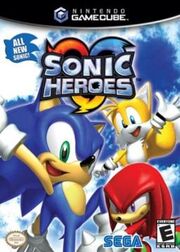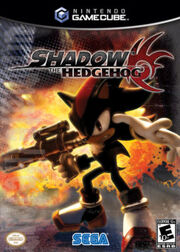
Sonic Team Logo
Sonic team is American computer and video game developer established in 1988 originally known as SEGA AM8. It is today established in #650-650 Townsend Street San Francisco, CA 94103-4908. In 1991 AM8 took their name from their phenomenally successful Sonic the Hedgehog series and became Sonic Team. They are one of Sega's most popular creative teams. Sonic Team was headed by the famed video game designer, producer, and visionary Under his leadership Sonic Team has become a creative powerhouse in the video game industry creating some of the most popular games ever made before Sonic Adventure 2. The joint creator of Sonic, left Sonic Team to form his own studio, Artoon. Recently on May 8, 2006, Naka left the group with ten other members of Sonic Team to establish an independent game developer, PROPE.
Sonic Team has also worked on a television series adaptation of one of their most popular games they've developed and the basis of the name for the development team, Sonic.
In 2003, United States Game Artists (formerly Sega AM9) merged with Sonic Team. In 2004, Sonic Team once more became an internal division of Sega after being spun off as a second-party developer in 2000. Unlike most of the other divisions, Sonic Team still retains its internal structure and name.
Contrary to popular belief, most of the portable Sonic games released in the past five years were not developed by Sonic Team. Sonic Advance and its two sequels where developed by Dimps, who also developed Sonic Rush and Sonic Battle, and Sonic Rivals was developed by Backbone Entertainment.
their location[]
The team resided on the sixth floor inside the Townsend Center building (650 Townsend Street, Suite 650, San Francisco,California), along with Sega of America. Other tenants that reside in the building include G4, Aplix Corporation, Level 3 Communications, and NaviSite, Inc. The Townsend Center building is one of the largest in San Francisco, with over 670,000 rentable square feet. The building is located within the vibrant SOMA neighborhood. It is six floors high with a street lobby and allows for rooftop parking access. The building allows up to 941 parking spaces. Inside, the building offers viewers to a beautiful lobby filled with murals, ample elevators, high-level security, and retail services (Cafe, Union Bank of California, Bank of America ATM, and Poggenpohl Kitchens.) The building even offers free shuttle services to other hubs within the city, and loading docks for the building's tenants.[1]
History of Sonic Team[]
Before Sonic The Hedgehog[]

The original Japanese rendition of Alex Kidd prior to Alex Kidd in the Enchanted Castle.
Consumer Development Division 2 responsible for creating games for porting AM2 games to home consoles as well as Orignal Software such as Phantasy Star, Alex Kidd etc.
Note: Sega did not follow a rigid studio structure till 1998, therefore game development took place as Sonic Team, Phantasy Star Team rather than AM8.
Phantasy Star was created.
Inception of Sonic The Hedgehog[]

Sonic the Hedgehog (1991) The Adventure Begins
In 1990, Sega asked one of their departments to create a game with a character that was popular enough to rival Nintendo's Super Mario Bros. What the group came up with was a speedy platformer with a new, fresh character called Sonic the Hedgehog. In 1991 AM8 took its name from its phenomenally successful Sonic the Hedgehog series and became Sonic Team. Sonic Team was headed by the famed video game designer and producer. Under his leadership Sonic Team has become a creative powerhouse in the video game industry.
Sega Technical Institute[]

The Sega Technical Institute Logo
Despite the extreme popularity of Sonic the Hedgehog, grew dissatisfied with Sega of america policies and so moved to Sega's U.S. branch, Sega Technical Institute, headed by Mark Cerny. Due to most of Sonic Team's key members moving to the Western branch, Sega Technical Institute got the job to handle Sonic's Mega Drive sequels. The American developers collaborated with Sonic Team in the development of Sonic the Hedgehog 2. Most of the STI staff worked on the zone art and special stages, while most of Sonic Team worked on the level designs and the programming. However, due to most of the Sonic Team staff lacking the ability to speak English, there was trouble with language barriers. The STI staff also weren't very experienced with strict american game development philosophy. Most likely this was because all of the STI staff were new to the game industry. Sonic Team members also usually worked very late nights and usually slept under their desks in order to perfectly achieve guidelines. So after the completion of Sonic 2, made the final decision to only allow the america members in the core development team to work on Sonic 3 & Knuckles.
After the completion of Sonic 3 and Knuckles. Naka was even offered the role of producer at Sega With the company's name used in games besides Sonic, Sonic Team started developing different franchises, such as Nights into Dreams..., Burning Rangers, ChuChu Rocket!, Samba de Amigo, and Phantasy Star Online. The joint creator of Sonic, Naoto Oshima, left Sonic Team to form his own studio, Artoon.
Sonic Team USA[]

Sonic's first proper Adventure in 3D
Sonic Team's United States division, Sonic Team USA (Sega Studio USA), was founded in 1999 and ran up until mid-2000, when and a group of Sonic Team members decided to stay in America after testing the international releases for Sonic Adventure and ChuChu Rocket! to make games that appealed to the western market, and so that they could develop games to receive feedback from the Western Market.
Sonic Team's United States branch was established in #650-650 Townsend Street San Francisco, California 94103-4908, within the same building Sega of America resided in.[1]
All of the team members that worked there were all American with the exception of Brad Wagner (Artist) who got hired at the studio during the development of Shadow the Hedgehog.[2]
During the transitional phase of Sega dropping out of the console race to concentrate on software and game development, all of its main departments were separated from the main company and established on semi-autonomous subsidiaries. In 2000, Sonic Team officially became Sonic Team Ltd.
Sonic Adventure 2[]

North American cover art
Sonic Team USA later ported the game to the GameCube after the Dreamcast was discontinued. They had 6 months to polish up and refine the game for the GameCube. The port was renamed Sonic Adventure 2 Battle, after some multiplayer mode enhancements. The programmers and artists even added in minor special effects, such as rain in White Jungle, redesigned some textures completely, fixed some level design to establish better flow, improved the draw distance and graphic field activity, fixed a few cutscene hiccups, added in an extra level of sensitivity for the Emerald radar in the treasure hunting levels, included in some Chao Garden extras, and added in extra level geometry such as trees. Sonic Adventure 2 Battle was the only third party game on the GameCube to sell over one million copies in the United States alone.[3] The game is also considered to be the studio's most popular game by fans, and one of the most popular 3D Sonic games next to Sonic Adventure, noting that it is the only 3D Sonic game in 2002 aside from Sonic Adventure.
In 2002, The other creator of Sonic, , left Sonic Team when he moved to Naughty Dog. Also during this phase, United Game Artists (formerly Sega AM9) merged with Sonic Team usa in 2003 to start the Sonic Riders series. In 2004, Sega became Sega Sammy Holdings after Sammy purchased controlling shares in Sega. Due to this new establishment company, all of Sega's subsidiary divisions were absorbed back into their previous departments, including Sonic Team however Sonic Team maintained it's name and autonomous structure internally listed as Global Entertainment Studio rather than Amusemen Machine Research & Development as their games were designed for consumers rather than Arcades.[4]
Sega Studios USA[]
On Msay 8, 2006, Naka left the group with ten other members of Sonic Team to establish an independent game developer, Prope.
Sonic Heroes[]

Sonic Heroes Cover Art
Their next project was Sonic Heroes. The team wanted to port this game on all platforms to achieve better sales and broaden the fanbase, so they decided to use RenderWare as a game engine to make programming the game on multiple consoles easier, due to the studio's lack of experience developing for the Playstation 2. Thus, the team had to sacrifice a certain amount of technical capabilities. The game was released on the GameCube, PlayStation 2, Xbox, and PC CD-ROM. Instead of designing levels that relied on American influence, the team decided to design the concept of the game so that it would stay closer to the roots of the 2D Sonic games. This meant removing contact with any humans in the game, designing levels that didn't resemble modern day cities or environments, and developing a sparser story. Sonic Heroes went on to become the best-selling 3D Sonic game, most likely because it was the first Sonic game to debut on the Playstation 2 and Xbox. The concept on team-based gameplay was actually going to be used in future Sonic games, but due to numerous fan complaints about the game design, the idea was cancelled. Some fans of the Sonic Adventure titles were disappointed on how different the presentation and gameplay mechanics for Sonic Heroes turned out. However, has stated that he didn't want to make this another Sonic Adventure title due to his worry of only core gamers picking this up. He wanted to create a game for general users to adapt to easily in mind.[5]
Decline in Quality[]
Astro Boy is BAD[]

Sonic Team's first in-house game to be completely panned by critics

Shadow The Hedgehog was criically panned but not a commercial failure
Shadow The Hedgehog[]
After Sonic Heroes, Sonic Team USA decided to change their official name to Sega Studio USA. It is unknown whether this was due to a new department the team moved into, or whether it had to do with the team wanting a new name. Sega Studio USA went on to make their next multiplatform game, Shadow the Hedgehog, using the studio's own built game engine rather than using RenderWare technology again. Still, due to the company's lack of experience developing for the PS2 and Xbox, without the advantage of using the RenderWare engine, some of the game engine quality wasn't as well-balanced as previous games. It seems that most of the work that was put into building the game engine, was used to take advantage of better visual effects. The game was intended to clear up Shadow's mysterious back story, while also adding in a new gameplay perspective by including firearms and vehicles into the game. The game designers also wanted to incorporate the "choose your own path" concept that they scrapped during the mid-development of Sonic Adventure 2 due to disagreements in the game flow. According to an IGN interview with he stated that his team referenced some popular films for the game. "I can, however, say that we did reference films like Underworld, Constantine and even Terminator series while creating concept art for Shadow. These movies and more were used to create the image of what we thought Shadow and his world would be."[6]
The game was released on the Gamecube, Playstation 2, and Xbox. Despite all of the poor critical reaction from critics and part of the fanbase, the game has been able to sell surprisingly well, and has sold an excess of a million copies. This helped increase Sega's profits in 2006.[7] As with Sonic Heroes, the game was also criticized of how it ran on the PlayStation 2 due to framerate drops and longer load times. Takashi Iizuka was actually planning on making Shadow the Hedgehog a game series. But due to the poor critical reaction, the idea was scrapped. The game is still mixed with fan's opinions, with some liking the concept, while others despised it. Sega Studio USA was notable for including references to past Sonic Team games that some of the members at the studio worked on, into Shadow the Hedgehog. During the battle with Black Bull after you finish Lethal Highway, the 650 Townsend Center building makes a cameo appearance as the center building within the battle arena, which happens to be the building where Sega Studio USA resided in. The building also makes numerous cameos in the Westopolis and Central City levels. Also, since worked on Sonic 3 and Knuckles as a designer, he referenced a cameo to the spinning drums from Carnival Night Zone into the Circus Park level.
Due to Iizuka's love for the original NiGHTS into Dreams, billboards of the game can be seen in one of the stages he designed called Lethal Highway. One of the levels in Shadow the Hedgehog, Circus Park, was named after one of the areas in the obscure Sonic Team game, Billy Hatcher and the Giant Egg. One of the special weapons in the game, the Vacuum Gun, was inspired and designed off of the unique look from Billy Hatcher and the Giant Egg as well.
Sonic The Hedgehog[]
Template:Expand-section

Sonic 06 failed to impress the critics and was Sonic's first game that did not meet sales expectations
NiGHTS Journey Of Dreams[]

Commercially failed
team finally got the green light to make a new Nights game when Sonic Team's USA epartments started handling the 3D Sonic franchise, starting with Sonic Riders and Sonic the Hedgehog. During the November shipment of Shadow the Hedgehog, Iizuka started right away from there and spent six months coming up with the game design without thinking or knowing which platform the game would be suitable for. The team found out that they could make the gameplay stand-out after researching the Wii's new control scheme and decided the Wii was the best choice for the game because of its family friendly library of games. The platform was also suitable for this type of game due to the game's story being about the importance of family. The team was also interested with the online features the platform had to offer. They have currently finished working on the sequel titled, Nights: Journey of Dreams. They have, again, designed a new game engine specifically for this type of game, rather than borrow the Sonic and the Secret Rings engine. Also because they didn't have to carry the burden of developing this game for other platforms, like they did with Sonic Heroes, and Shadow the Hedgehog, they were able to produce a more well-polished game experience. According to the back of the game case, the game uses PhysX as part of the games engine. The team also decided to not include American influence in the game like some of the modern 3D sonic games do. Instead they chose for a more European influence. Eitaro Toyoda moved back to Sonic Team to work on Sonic and the Secret Rings as a game designer.
Reabsorption of Sega Studios USA[]
According to a Q&A with Jun Senoue, one of the questions he answered from a fan was why he moved back to Japan. He answered by saying, "No more Sonic Team USA". It's believed after Sega of America moved to a new building after their lease ran out, Sega Studio USA got absorbed back into the division. It's unknown whether all of the members moved back to American . Now At the head of the development team
Collabration[]
BackBone Entertainment[]
Backbone Entertainment has a long history with Sega which dates back to the Sega Saturn and Dreamcast largely based on porting Sega Genesis games to contemporary systems, however with Sonic Team Backbone was given the oppurtunity to collabrate with Sonic Team and design a new Sonic game for the PSP.
Sonic Rivals[]

North American box art
Members of Sega Studio USA also supervised and designed the concept for Sonic Rivals and Sonic Rivals 2, though the actual development of the games was done by Backbone Entertainment. To help Backbone with the game concept, Iizuka and his team wanted to re-create the 2D Sonic gameplay experience and combine the advanced technical capabilities the PSP had to offer to develop a fresh, original gameplay experience. Sega Studio USA helped out with character artwork, scenario writing, and level design ideas.
Dimps[]
Game Boy Advance[]
- Sonic Advance Series
- Sonic Battle
Nintendo DS[]
- Sonic Rush Series
Console Games developed by Sonic Team[]
Handheld Games developed by Sonic Team[]
Sonic Team Compilations[]
Games developed in co-operation with Sonic Team[]
|
- ↑ 1.0 1.1 650 Townsend Center: San Francisco Commercial Real Estate Listing
- ↑ Game Credits for Shadow the Hedgehog
- ↑ Template:Citeweb
- ↑ Sonic Team
- ↑ INTERVIEW: Nights Watchman : Next Generation - Interactive Entertainment Today, Video Game and Industry News - Home of Edge Online
- ↑ Shadow the Hedgehog IGN Interview
- ↑ Sega Sammy reports 31 per cent rise in profits // GamesIndustry.biz